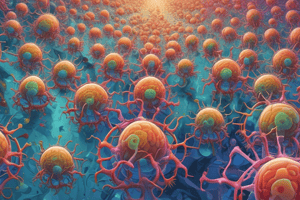Podcast
Questions and Answers
Where does DNA replication typically occur for DNA viruses?
Where does DNA replication typically occur for DNA viruses?
- Cytoplasm
- Mitochondria
- Nucleus (correct)
- Endoplasmic Reticulum
Which step in virus replication involves the synthesis of viral proteins?
Which step in virus replication involves the synthesis of viral proteins?
- Entry into cell
- Replication of viral nucleic acid (correct)
- Uncoating of DNA/RNA
- Assembly
What happens when non-enveloped viruses complete their replication cycle?
What happens when non-enveloped viruses complete their replication cycle?
- Viral particles remain dormant
- Host cell is usually destroyed (correct)
- Host cell undergoes apoptosis
- Viruses migrate to a new host
What is the function of peplomers in enveloped viruses?
What is the function of peplomers in enveloped viruses?
Which of the following steps directly precedes the release of virus particles from the host cell?
Which of the following steps directly precedes the release of virus particles from the host cell?
What is the role of specific receptors during the attachment of a virus to a host cell?
What is the role of specific receptors during the attachment of a virus to a host cell?
What is essential for infectivity in most enveloped viruses?
What is essential for infectivity in most enveloped viruses?
Which process allows the release of viral nucleic acid from the capsid?
Which process allows the release of viral nucleic acid from the capsid?
Which structure is disrupted in a virion allowing the nucleocapsid to spill out?
Which structure is disrupted in a virion allowing the nucleocapsid to spill out?
How do most DNA viruses produce proteins coded by the virus?
How do most DNA viruses produce proteins coded by the virus?
In virus entry mechanisms, what is central to enveloped viruses that enter by fusion?
In virus entry mechanisms, what is central to enveloped viruses that enter by fusion?
What makes non-enveloped viruses tougher compared to enveloped viruses?
What makes non-enveloped viruses tougher compared to enveloped viruses?
What is the function of peplomers on a virus envelope?
What is the function of peplomers on a virus envelope?
Which component of a virus provides rigidity to the virion?
Which component of a virus provides rigidity to the virion?
What is the role of viral nucleic acid in virus replication?
What is the role of viral nucleic acid in virus replication?
In what form can viral nucleic acid exist?
In what form can viral nucleic acid exist?
Where do viruses usually replicate within host cells?
Where do viruses usually replicate within host cells?
What key role does host cell 'machinery' play in virus replication?
What key role does host cell 'machinery' play in virus replication?
Flashcards are hidden until you start studying
Study Notes
DNA Replication and Virus Properties
- DNA replication for DNA viruses typically occurs in the nucleus of the host cell.
- Viral proteins are synthesized during the translation phase of virus replication.
Non-enveloped and Enveloped Virus Lifecycle
- Non-enveloped viruses release their particles through cell lysis at the completion of their replication cycle.
- Peplomers, or glycoprotein spikes, on enveloped viruses facilitate attachment and entry into host cells.
Virus Release and Attachment
- The step directly preceding the release of virus particles is the assembly of viral components.
- Specific receptors on host cells are essential for the initial attachment of viruses, ensuring specificity and infectivity.
Essential Components and Functions
- Envelope integrity is essential for infectivity in most enveloped viruses; loss of the envelope prohibits effective infection.
- Viral nucleic acid is released from the capsid through a process called uncoating.
Nucleocapsid Dynamics
- The capsid structure is disrupted during uncoating, leading to the exposure of the nucleocapsid.
- Most DNA viruses produce proteins using host ribosomes and cellular machinery.
Entry Mechanisms and Virus Resistance
- Fusion is a central mechanism for enveloped viruses, allowing direct entry into the host cell cytoplasm.
- Non-enveloped viruses tend to be more resilient to environmental conditions due to the lack of a lipid envelope.
Structure and Function Insights
- Peplomers on the virus envelope serve as key structures for binding to host cell receptors.
- The capsid provides rigidity to the virion, protecting viral genetic material.
Role of Viral Components
- Viral nucleic acid is crucial for replication, directing the synthesis of new viral components.
- Viral nucleic acid can exist in forms including single-stranded or double-stranded DNA/RNA.
Site of Replication
- Viruses typically replicate within the cytoplasm or nucleus of host cells, utilizing cellular machinery for replication and protein synthesis.
- Host cell machinery is vital for replicating viral components and facilitating the overall virus life cycle.
Studying That Suits You
Use AI to generate personalized quizzes and flashcards to suit your learning preferences.




